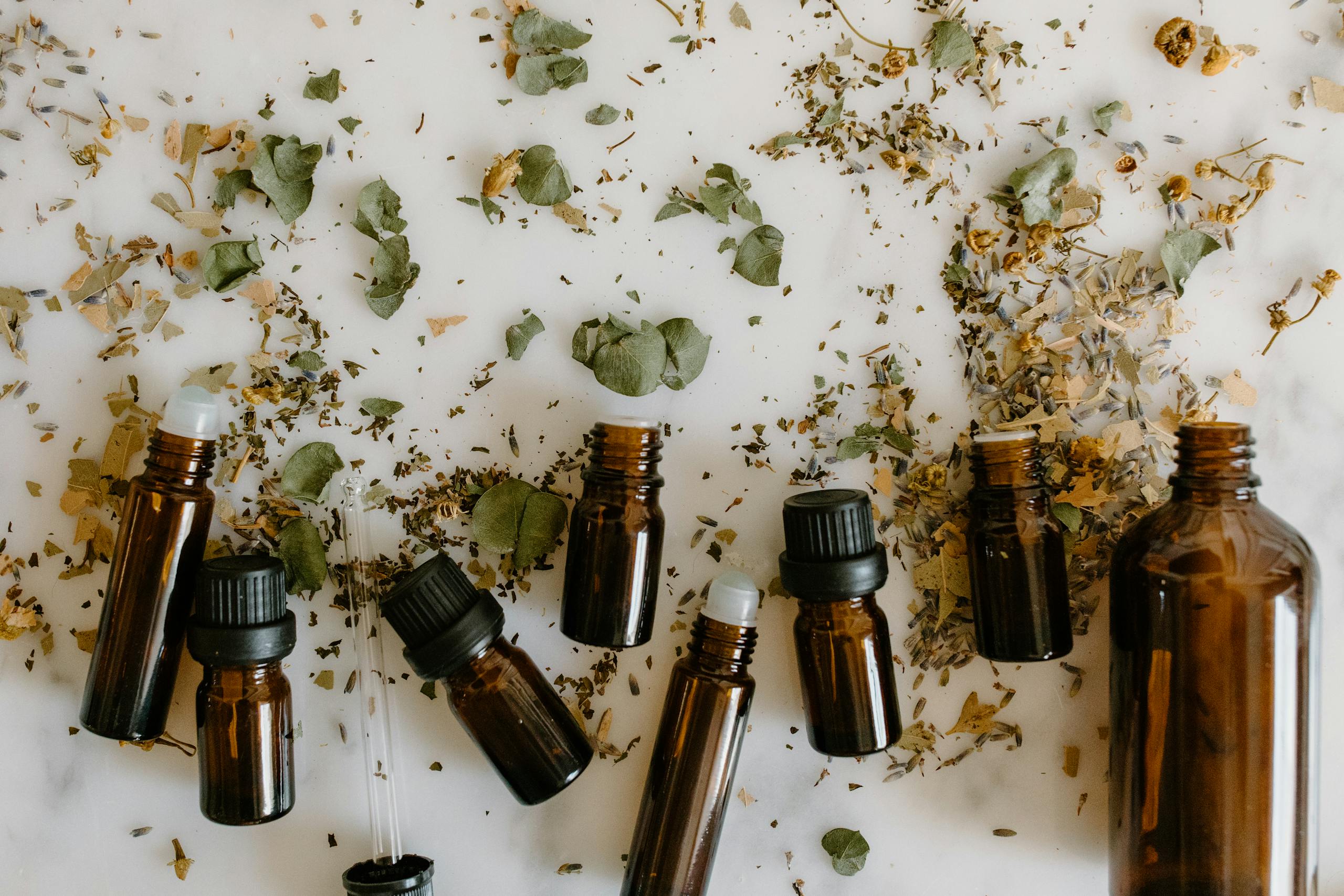More people are turning to natural pain management solutions as they seek safer alternatives with fewer side effects. If you’re dealing with chronic conditions like arthritis, neuropathy, or persistent muscle tension—or experiencing episodes of acute pain—you know the challenge of finding effective relief that won’t burden your body with harsh chemicals.
Topical herbs are the answer. These natural remedies work directly through your skin to target pain at the source, providing localized relief without the systemic effects of oral meds. They can be an alternative or complement to conventional medicine for pain management, making them perfect for long-term use and gentle enough for daily use.
In this guide, you’ll learn how specific topical herbs like chamomile, calendula, and rosemary can support chronic pain management. We’ll explore their unique properties, practical applications for common conditions, and simple ways to incorporate these natural remedies into your wellness routine.
What is Herbal Medicine
Herbal medicine has been the backbone of traditional medicine for centuries, providing natural ways to relieve pain, reduce inflammation, and support overall well-being. Long before the invention of nonsteroidal anti-inflammatory drugs (NSAIDs), people turned to herbal remedies to manage joint and muscle pain, soothe chronic inflammation, and promote healing. Today, as interest in alternative medicine grows, many are rediscovering the benefits of these time-honored treatments for pain management.
Scientific research is continuing to validate the effectiveness of herbal medicine. For example, a study published in the Journal of Ethnopharmacology (doi: 10.1016) shows how specific herbal treatments can significantly reduce musculoskeletal pain and relieve pain for rheumatoid arthritis and osteoarthritis. Herbs like willow bark and turmeric are well known for their anti-inflammatory properties, making them great allies in reducing pain and alleviating joint and muscle pain symptoms.
Essential oils also play a big role in herbal medicine. Lavender essential oil, for example, is famous for reducing pain signals, promoting relaxation, and even supporting wound healing. These natural remedies work harmoniously with the body, providing pain-relieving properties without the harsh side effects often associated with conventional anti-inflammatory drugs. While herbal remedies can be powerful pain relief and well-being tools, use them wisely.
Some herbs and essential oils can interact with medications or cause allergic reactions, especially if you have conditions like high blood pressure, liver disease, or ulcerative colitis. Always consult a healthcare professional before adding new herbal remedies to your routine, especially if you are managing chronic diseases or taking prescription medications. This way, you can enjoy the benefits of herbal medicine safely and effectively.
What are Topical Herbs, Herbal Medicine, and Their Benefits
Topical herbs are plant-based remedies applied directly to the skin in creams, salves, oils, or poultices. When applied topically, these herbs deliver their active compounds through the skin’s layers to the underlying tissues, muscles, and joints where pain originates.
The benefits of topical application make these herbs perfect for chronic pain management:
Localized relief targets specific areas without affecting your whole system. This precision allows you to treat only the areas that need attention while avoiding exposure elsewhere in your body.
Reduced systemic absorption means fewer potential interactions with medications or unwanted effects on organs like the stomach or liver. This safety profile makes topical herbs suitable for long-term use.
Ease of use allows you to apply relief exactly when and where you need it. Unlike oral medications that require timing around meals or specific schedules, topical herbs can be used as symptoms arise.
Compared to common over-the-counter pain medications, topical herbs have several advantages. While oral pain relievers can cause stomach irritation, stomach upset, liver stress, or drowsiness, herbal topicals work gently with your body’s natural healing processes. They provide cumulative benefits that often improve with consistent use rather than masking symptoms temporarily.
Topical herbs come in various forms, and olive oil is a common carrier oil used to dilute and safely apply herbal preparations to the skin. Herbal medicine grows from various plants cultivated in specific regions, emphasizing these remedies’ natural origins and traditional use.
Topical Herbs for Pain Relief
Chamomile
Chamomile’s anti-inflammatory and calming properties are excellent for arthritis and muscle tension. This gentle herb contains flavonoids that reduce inflammation in tissues and joints. Its soothing nature also calms irritated nerves that contribute to chronic pain. Typical uses include chamomile creams, salves, and oils. These can be massaged into affected areas or applied as gentle compresses. Many people find chamomile works well for evening applications as its calming properties can help with sleep and pain relief. Chamomile can also help with menstrual cramp discomfort due to its soothing and anti-inflammatory properties.
Calendula
Calendula is excellent for skin discomfort caused by neuropathy and gentle pain relief. This bright orange flower contains compounds that support skin healing and reduce inflammation on the surface, making it perfect for sensitive areas affected by nerve pain.
Calendula supports skin healing and inflammation. Its gentle nature makes it suitable for areas where skin has become tender or irritated from chronic conditions. However, essential oils or specific herbal preparations should not be applied directly to broken skin to avoid irritation. This herb is a base ingredient in combination formulas as it rarely causes sensitivity reactions.
Rosemary
Rosemary is a natural muscle relaxant and circulation booster, making it great for stiffness and soreness from exercise or chronic strain. This aromatic herb contains compounds that create warming effects, allowing for deeper tissue penetration. Rosemary can also help with muscle pain through its warming and circulation-boosting effects.
The warming properties of rosemary increase blood flow to the treated areas, reducing stiffness and improving mobility. This makes it perfect for morning applications when joints and muscles feel stiff from inactivity during sleep.
Best for Chronic Conditions
Arthritis Support
For arthritis management, chamomile’s anti-inflammatory properties can help reduce joint pain and swelling. These properties can also help decrease pain and can be used alongside conventional therapies for arthritis. Apply chamomile-based preparations to affected joints twice daily, using gentle circular motions to avoid irritating sensitive areas.
Rosemary provides targeted pain relief and helps with stiffness, common in arthritic joints. Its warming effects can be beneficial during cold weather when arthritis symptoms worsen. Some herbs work by interacting with pain receptors to provide relief.
Some herbs may help arthritis by modulating inflammation pathways, such as suppressing the tumor necrosis factor involved in joint swelling and pain.
Neuropathy Relief
Calendula’s gentle nature makes it perfect for sensitive areas affected by neuropathy. This herb can calm irritated nerve endings without causing more sensitivity. Calendula and other topical herbs can help manage neuropathic pain by soothing irritated nerves. Apply calendula preparations lightly to affected areas; don’t rub vigorously, as this may increase discomfort.
Muscle Tension Relief
Both rosemary and chamomile work well to loosen tight muscles naturally. Rosemary’s warming properties relax muscle fibers while chamomile’s anti-inflammatory effects address underlying tension causes.
For extra benefits, try combining herbs in custom blends. A rosemary-chamomile oil blend can provide immediate warming relief and long-term anti-inflammatory benefits. Mix equal parts of each herb-infused oil and apply to tense muscle groups as needed.
How to Choose and Use Topical Herbs
When choosing herb-based products, be wise to ensure safety and effectiveness. The quality of ingredients, sourcing methods, and absence of synthetic additives all play a big role in the potency of herbal remedies. Whether you opt for ready-made products or decide to make your own herbal infusions at home, follow these best practices.
These guidelines will help you get the most out of topical herbs while minimizing risks and ensuring safe use.
- Prioritize Organic and Well-Sourced Ingredients: To avoid pesticides and contaminants, choose products made from organically grown herbs. Look for manufacturers that provide transparency about their sourcing and extraction processes.
- Check for Active Herb Concentration: Effective herbal products clearly state the concentration of active ingredients. Avoid products with long lists of synthetic additives that may dilute the potency or cause adverse reactions.
- Be Aware of Regulatory Limitations: The Food and Drug Administration (FDA) does not regulate herbal remedies for quality or safety. Always buy from reputable sources to reduce the risk of contamination or mislabeling.
- DIY Herb-Infused Oils: You can make topical herbal oils by combining dried herbs like chamomile with carrier oils like olive or coconut oil. Warm the mixture to extract active compounds, then strain and store correctly.
- Perform Patch Tests: Before applying any new herbal product extensively, test a small amount on your inner wrist and wait 24 hours to monitor for sensitivity or allergic reactions.
- Consult Healthcare Professionals: Herbal remedies can interact with prescription medications. Always talk to your healthcare provider about new herbal treatments, especially if you have existing health conditions or are on medication.
- Consistency is Key: Regular application of topical herbs often yields better results than sporadic use. These natural compounds work gradually, supporting your body’s healing processes.
- Support with a Healthy Diet: Use topical treatments with a healthy diet to boost overall wellness and the effectiveness of herbal remedies.
Create Your Natural Pain Management Plan
Apply topical herbs at specific times of the day. Many people find morning and evening applications work well, allowing herbs to work throughout the day and support recovery during sleep.
Combine topical herbs with other natural practices for extra pain relief. Gentle stretching, meditation, or warm baths can complement herbal treatments and create a whole approach to pain management. Ayurvedic medicine also uses topical herbs and holistic practices for pain relief, using traditional systems that use natural remedies.
Keep a journal to track your progress, see which herbs work for specific symptoms, and note application times, herb combinations, and pain levels before and after treatment. This will help you refine your approach and get better results over time.
Get Started with Natural Relief
Topical herbs are a safe and effective way to manage chronic pain without the side effects of conventional medications. These gentle remedies work with your body’s natural healing processes to provide targeted relief where you need it.
While herbs work gently, they can make a big difference with regular use. The cumulative benefits build up over time, often providing more sustainable relief than quick fixes that mask symptoms temporarily.
Start using topical herbs today. Whether you buy products or make your own, these natural remedies can be valuable additions to your pain management toolkit.
Ready to learn more about natural pain relief options? Sign up for our newsletter for ongoing tips on natural pain management and holistic health approaches to support your journey to lasting relief.
Medical Disclaimer:
This content is for informational purposes only and is not intended as medical advice, diagnosis, or treatment. Always consult with a qualified healthcare professional before making any changes to your diet, exercise, or health routine. Never disregard professional medical advice or delay seeking it because of something you have read on this site.







